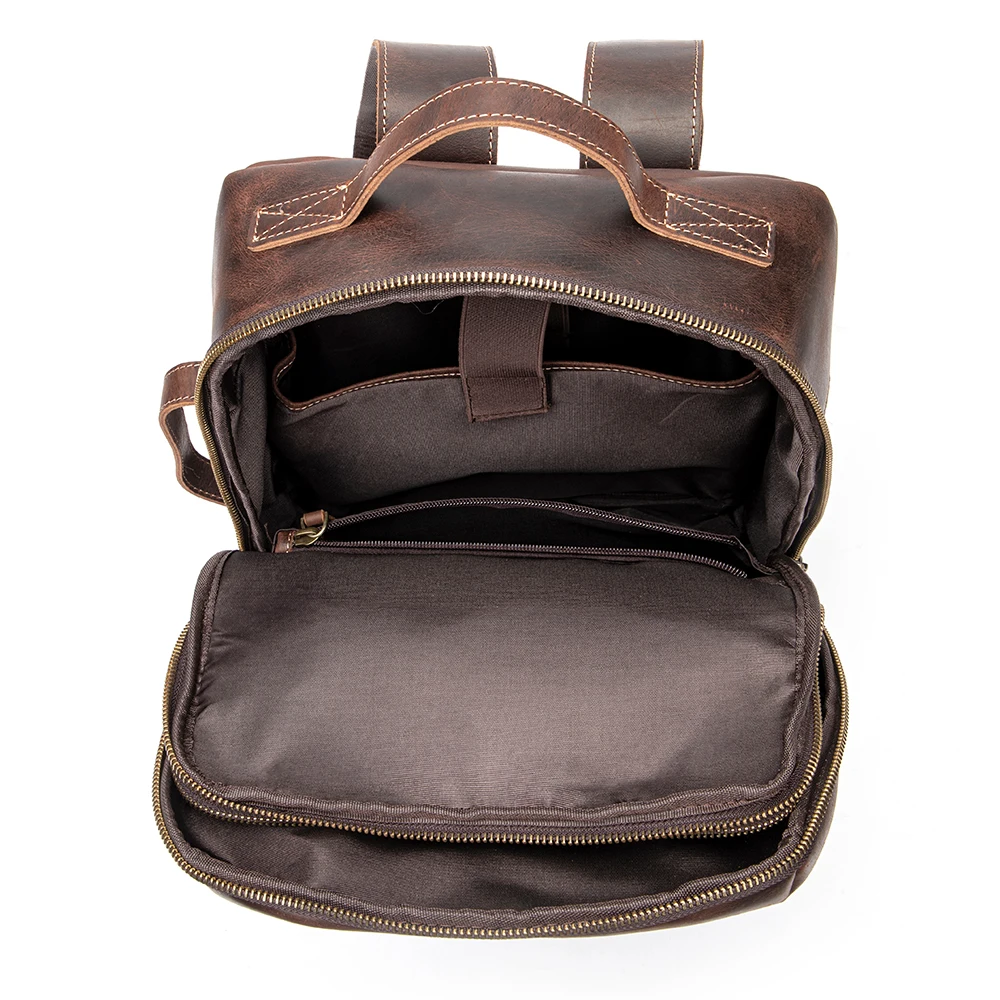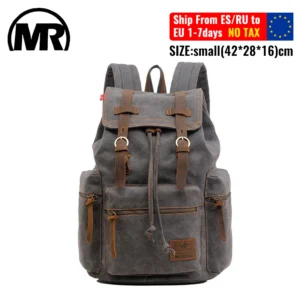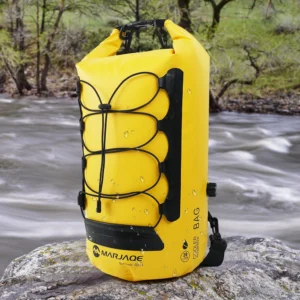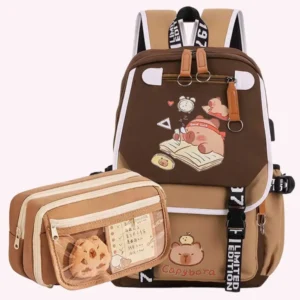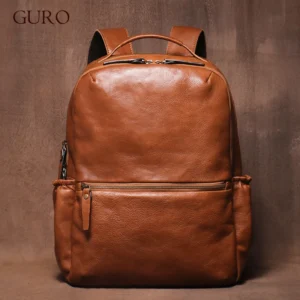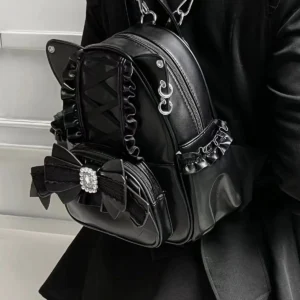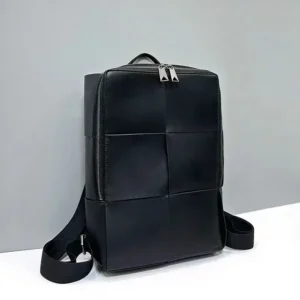Introduction: Understanding Roll-Top Leather Backpacks
Roll-top backpacks are distinguished by their unique closure system—instead of using zippers or drawstrings, these bags feature a flexible upper portion that folds or rolls down multiple times before being secured with buckles or straps. This distinctive design originated from military and outdoor equipment, where weather protection was paramount, but has now found its way into urban settings thanks to its blend of functionality and style.
Leather makes an exceptional material for roll-top designs because of its natural durability and flexibility. Quality leather moves with you while maintaining structural integrity, and when properly treated, offers considerable resistance to moisture. As time passes, the leather adapts to the rolling motion, creating smooth, consistent folds that enhance the backpack’s performance.
The combination of the roll-top mechanism with premium leather creates a backpack that offers adjustable capacity, superior weather protection, and remarkable durability—all while developing a unique character that improves with age. Many urban commuters and travelers have embraced roll-top leather backpacks for their practical benefits wrapped in timeless aesthetics.
This guide will take you through everything you need to know about how these functional pieces work, from their basic structure to the physics behind their weather resistance.
The Anatomy of a Roll-Top Leather Backpack
To understand how roll-top leather backpacks function, we first need to examine their key components:
- Main compartment – Typically features one large, open chamber rather than multiple divided sections, maximizing flexible storage
- Roll-top closure area – Contains reinforced edges and extra material specifically designed to withstand repeated folding without cracking or weakening
- Securing mechanisms – Usually includes buckles, straps, or hooks that hold the rolled portion in place and determine how tightly the bag closes
- Shoulder straps and back panel – Often padded and ergonomically designed to distribute weight effectively
- Secondary access points – Some models include side zippers or additional pockets for quick access to smaller items
The leather used in quality roll-tops requires specific design considerations. The material around the roll area needs to be thick enough for durability but supple enough to fold repeatedly without cracking. Key stress points where straps attach are typically reinforced with additional stitching or rivets.
Regular leather maintenance for commuters is essential to keep these components functioning properly over time, particularly the areas subjected to repeated folding and flexing.
What makes these backpacks special is how these individual components work as an integrated system. The flexibility of the top contrasts with the structured base, creating a backpack that adapts to your needs while maintaining its shape where it matters most.
The Mechanism: How a Roll-Top Closure Works
The roll-top closure is remarkably simple yet effective. Here’s how it operates:
- Loading phase – The top opens wide, providing full access to the main compartment for easy packing
- Alignment preparation – Before closing, the top edges need to be aligned evenly to ensure a proper seal
- Rolling technique – The top is folded over itself 2-3 times (the optimal number for most designs), creating multiple layers of material
- Securing – Once rolled to the desired height, the closure is secured using buckles, straps, or hooks that pull the rolled material tight
The physics behind this design is fascinating. Each fold creates another barrier against water infiltration. When properly secured, the pressure is distributed evenly across the roll, creating compression that forms a remarkably effective seal. Unlike zippers that have teeth that can separate or allow water through small openings, a rolled closure creates overlapping layers of material.
This mechanism also explains why roll-tops excel at waterproof leather backpack features compared to other closure types. Water hitting the backpack would need to travel upward against the folds to enter the bag—something that rarely happens in normal rain conditions.
Additionally, the rolling mechanism allows for variable height adjustment. When carrying bulkier items, you might roll only once or twice; when the bag is less full, you can roll several more times, effectively changing the bag’s volume.
Adjustable Capacity: The Expandability Advantage
One of the most practical benefits of roll-top backpacks is their adaptable capacity. Most designs allow for approximately 20-40% variation in volume, depending on how many times you roll the top and where you secure it.
This expandability makes large leather backpacks with roll-top designs particularly versatile for daily life. Imagine starting your morning commute with a packed lunch, gym clothes, and a laptop. After your workout and lunch, the bag is half-empty, so you can roll the top down further, creating a more compact profile for the journey home.
The leather material complements this adjustable design perfectly. Unlike rigid materials that might crack when bent repeatedly, quality leather remains flexible while providing enough structure to maintain the backpack’s overall shape. As the leather ages and softens slightly, this balance between flexibility and structure often improves.
This expandability feature also helps with load stabilization. When properly rolled down to match the volume of your contents, items stay more secure and shift less during movement—a notable advantage over fixed-volume bags that leave empty space when not fully packed.
Weather Protection: Creating an Effective Barrier
The roll-top design creates one of the most weather-resistant closure systems available in everyday backpacks. When properly executed, the rolled seal forms multiple overlapping layers that provide superior protection against rain, snow, and dust.
Each fold in the roll-top creates another barrier that water would need to penetrate. Unlike zippers, which can allow moisture through their teeth even when closed, the roll-top design eliminates this vulnerability entirely. The physics of the design means that water would need to travel upward against gravity and through multiple layers of material to reach the contents.
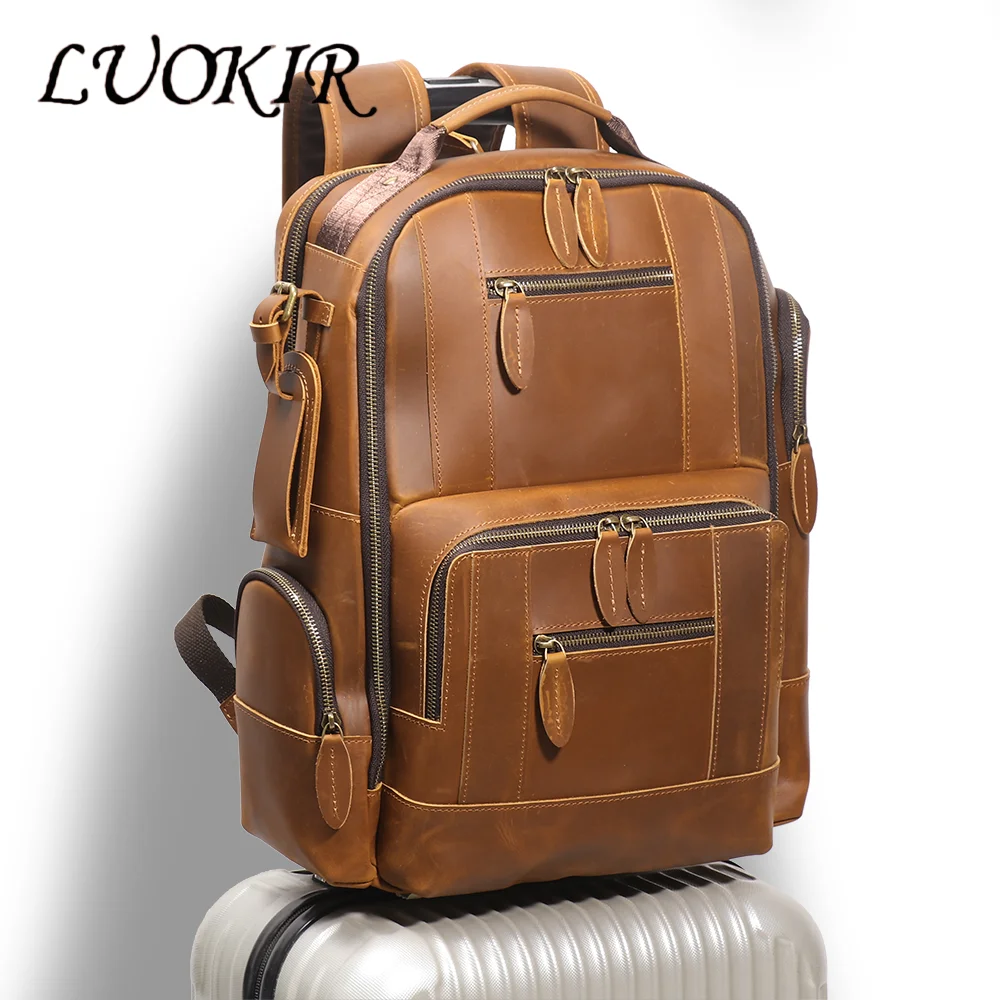
Quality leather enhances this protection when properly treated. While untreated leather can absorb moisture, leather conditioning and waterproofing creates a surface that naturally repels water. The combination of treated leather and the roll-top mechanism provides excellent protection in everyday conditions.
It’s important to note that these backpacks are highly water-resistant rather than completely waterproof. In light to moderate rain, your belongings will stay dry, but complete submersion or extended exposure to heavy downpours may eventually allow moisture to penetrate. For most daily urban use, however, the weather protection offered is more than sufficient.
The Security Aspect: Protecting Your Belongings
Roll-top designs offer a security advantage that’s often overlooked. Unlike zippers that can be quickly and quietly opened, accessing the main compartment of a roll-top backpack requires multiple steps: unbuckling straps, unrolling the top, and opening the compartment. This process creates natural deterrence against quick theft attempts.
Additionally, the opening process makes a distinctive sound as buckles unsnap and leather unfolds—eliminating the silent access that makes zippered bags vulnerable in crowded areas. This feature makes vintage leather backpacks with roll-top designs particularly popular among urban commuters and travelers.
Leather adds another security dimension through its inherent durability. While fabric bags can be easily cut with a sharp object, leather—especially thick, full-grain leather—offers significant resistance to slashing attempts. This natural toughness provides peace of mind when traveling with valuable items.
The roll-top closure also prevents accidental spillage. Once secured, items cannot easily fall out of the bag even if it’s tipped over or jostled during active use. For cyclists and commuters who subject their bags to frequent movement, this secure containment is particularly valuable.
Accessibility and Organization of Contents
While roll-tops excel in security and weather protection, their design does create certain organizational considerations. Most roll-top backpacks feature a single main compartment rather than multiple divided sections. This design choice maximizes the bag’s flexibility but requires different organizational approaches.
The wide-mouth opening, when fully unrolled, offers exceptional access for packing and retrieving larger items. This makes roll-tops particularly effective for bulky gear like clothing or camera equipment. However, smaller items can be more challenging to locate quickly in the larger compartment.
To address this, many quality roll-top designs incorporate:
- Internal sleeves or dividers for laptops and documents
- Small inner pockets for valuables and frequently used items
- External quick-access pockets for items needed without opening the main compartment
- Hidden security pockets against the back panel for valuable items
Developing good leather backpack organization strategies becomes particularly important with roll-top designs. Many users find that small organizational pouches within the main compartment help maintain order without sacrificing the flexibility that makes these backpacks appealing.
The balance between accessibility and security is a key consideration. While items might take an extra moment to retrieve compared to zippered compartments, the trade-off is greater protection for your belongings.
Leather’s Role in Backpack Performance
The leather material plays a crucial role in how a roll-top backpack functions. Different leather types offer varying performance characteristics:
Full-grain leather – The highest quality option, featuring the entire grain layer with all natural fiber strength intact. This leather is exceptionally durable and develops a beautiful patina over time, making it ideal for the repeated flexing required by roll-tops.
Top-grain leather – Slightly thinner than full-grain as the outermost layer has been sanded away. Offers good durability with less weight, making it a balanced choice for daily use bags.
Vegetable-tanned leather – This refers to the tanning process rather than the cut. This traditional method creates firmer leather that provides excellent structure while still allowing the flexibility needed at the roll point.
The full-grain leather backpack construction particularly complements roll-top designs because it provides the perfect balance of structure and flexibility. The natural variations in the leather’s surface create a unique character that enhances the backpack’s appearance over time.
Leather’s weight, while sometimes considered a drawback, actually enhances the roll-top mechanism by providing natural resistance that helps the rolled portion stay in place. The material’s natural body helps the backpack maintain its shape even when not fully packed—something synthetic materials often fail to achieve.
Perhaps most importantly, quality leather improves with age. The patina that develops through handling and exposure creates a bag that becomes more personally yours with each use—a stark contrast to synthetic bags that typically degrade rather than improve over time.
Comfort and Ergonomics Considerations
Despite their functional advantages, roll-top leather backpacks require thoughtful design to ensure comfortable carrying. Quality models address the inherent weight of leather through several ergonomic features:
- Padded shoulder straps that distribute weight across a wider area
- Contoured back panels that follow the natural curve of the spine
- Strategic padding placement that promotes airflow and reduces sweating
- Chest straps that help distribute weight for heavier loads
- Properly positioned attachment points that optimize weight distribution
The roll-top design influences comfort in several ways. When properly rolled and secured, the closure system creates a balanced load that sits higher on the back—generally considered ideal for ergonomic carrying. This higher center of gravity helps the wearer maintain better posture compared to bags that sag lower.
Leather’s weight, while adding to the overall load, provides a stability advantage. The natural heft helps prevent the backpack from bouncing during active movement, something particularly appreciated by cyclists and those who navigate busy urban environments.
For all-day wear, proper adjustment becomes crucial. The straps should be set to keep the backpack relatively high on the back, with the weight carried primarily by the back muscles rather than pulling down on the shoulders.
Comparing Roll-Top vs. Zippered Backpacks
Understanding how roll-tops compare to traditional zippered backpacks helps clarify their unique advantages and limitations:
| Feature | Roll-Top Design | Zippered Design |
|---|---|---|
| Weather Resistance | Superior protection through overlapping layers | Vulnerable at zipper teeth even with flaps |
| Access Speed | Requires multiple steps to open/close | Quick access with single zipper pull |
| Organization | Typically single main compartment with few divisions | Often multiple separate compartments |
| Durability | Fewer mechanical failure points | Zippers can break or separate with age |
| Capacity Adjustment | Easily adjustable by 20-40% | Fixed capacity regardless of load |
| Security | Multi-step opening deters theft | Can be quietly opened in crowded settings |
| Weight Distribution | Better compression for partial loads | May leave empty space at top |
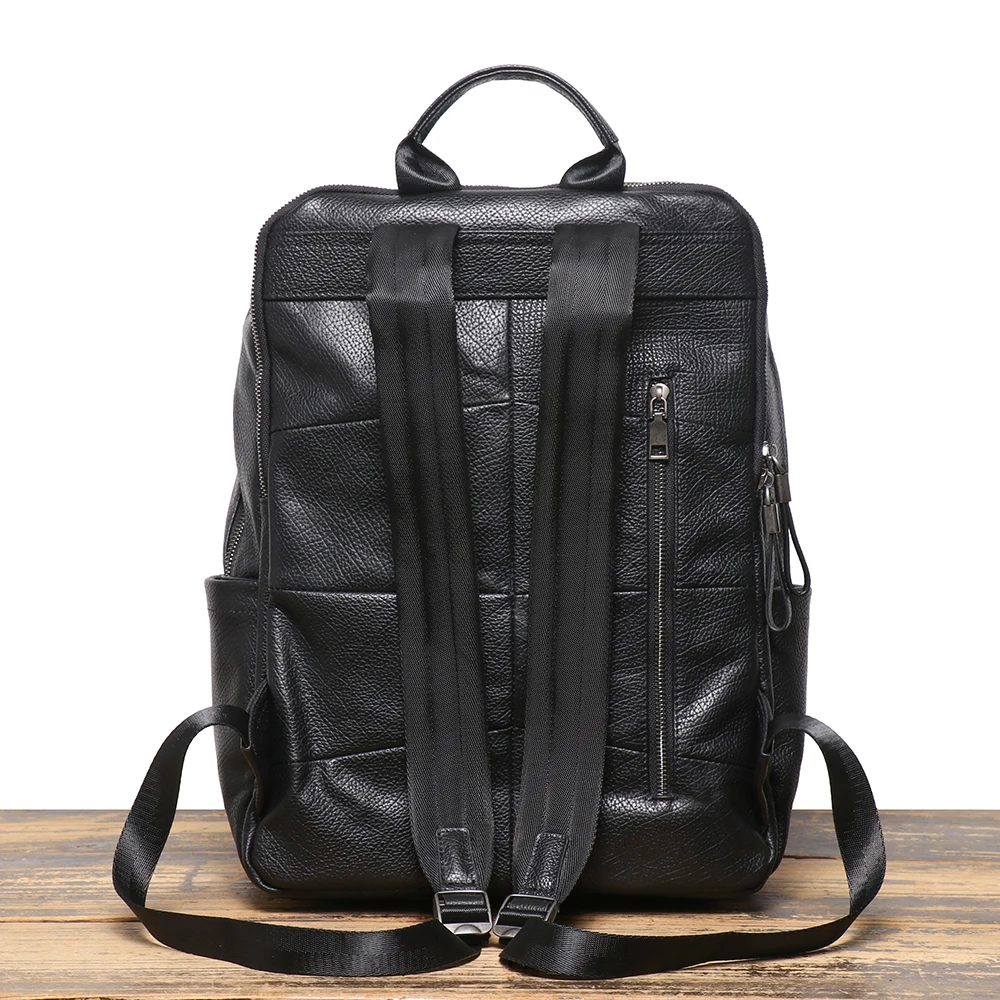
Roll-tops excel in situations where weather protection, durability, and adjustable capacity are priorities—making them popular among cyclists, commuters in rainy climates, and travelers who need flexibility. Zippered designs often work better for those who prioritize quick access and prefer having multiple organized compartments.
Professionals who need to frequently access specific items throughout the day might find zippered compartments more convenient, while those who typically pack their bag in the morning and unpack in the evening might prefer the secure, weather-resistant roll-top design.
Caring for Your Roll-Top Leather Backpack
Proper maintenance directly impacts how well your roll-top functions over time. The repeated folding places unique stress on the leather, making care particularly important:
- Regular cleaning – Wipe down with a slightly damp cloth every few weeks to remove dust and prevent buildup in creases
- Conditioning – Apply leather conditioner every 3-6 months, paying special attention to the folding area to maintain flexibility
- Waterproofing – Reapply waterproofing treatments before rainy seasons to maintain weather resistance
- Hardware maintenance – Occasionally check and tighten any screws or rivets in buckles and attachment points
- Storage – Store partially unrolled when not in use to reduce permanent creasing
The ultimate guide to conditioning leather backpacks provides detailed instructions for keeping the leather supple at the roll point—crucial for maintaining an effective seal. Similarly, understanding complete waterproofing techniques ensures your backpack continues to provide weather protection throughout its life.
When conditioning the roll area, work the product into the creases where the leather folds, as these areas experience the most flexing and can dry out faster than other parts of the bag. This attention to detail significantly extends the functional life of your backpack.
Remember that hardware needs attention too. The buckles and straps that secure the roll-top closure are essential to its function, so check them periodically for signs of wear and address any issues promptly.
Ideal Use Cases: When Roll-Top Leather Backpacks Excel
Roll-top leather backpacks are particularly well-suited for certain scenarios:
- Urban commuting with electronics – The weather resistance provides peace of mind when carrying laptops and tablets during unexpected rain showers
- Bicycle commuting – The secure closure prevents items from bouncing out during rides, and the weather protection shields contents from road spray and rain
- Variable-load days – When your carrying needs change throughout the day, the adjustable capacity adapts accordingly
- Travel situations – The security features make them ideal for crowded tourist areas where theft might be a concern
- Professional environments – Leather roll-tops offer functionality wrapped in an aesthetic that looks appropriate in business settings
The leather rucksack style with roll-top closure has become particularly popular among professionals who bike to work—they appreciate the combination of weather protection during the commute and professional appearance at the office.
However, roll-tops may be less ideal for situations requiring constant access to multiple small items throughout the day. Photographers who need to quickly grab different lenses or tools, for example, might find the single-compartment design and multi-step opening process less convenient than bags with specialized quick-access compartments.
14 Inch Leather Laptop Backpack, Brown Leather Backpack, Men's Leather Backpack, Vintage Leather Backpack
Price range: $177.28 through $199.12 Select options This product has multiple variants. The options may be chosen on the product pageCarry On Leather Backpack, Roll Top Leather Backpack
Price range: $77.76 through $96.48 Select options This product has multiple variants. The options may be chosen on the product page- Price range: $80.72 through $108.04 Select options This product has multiple variants. The options may be chosen on the product page
Full Grain Leather Backpack, Men's Leather Laptop Backpack, Men's Leather Work Backpack
$353.46 Select options This product has multiple variants. The options may be chosen on the product pageLarge Leather Backpack, Women's Leather Backpack
Price range: $97.12 through $97.96 Select options This product has multiple variants. The options may be chosen on the product pageMen's Leather Backpack, Men's Leather Laptop Backpack, Vintage Leather Backpack
Price range: $487.99 through $811.41 Select options This product has multiple variants. The options may be chosen on the product page
Ultimately, roll-top leather backpacks shine brightest when their unique combination of adjustability, protection, and style aligns with your daily needs and activities.
Common Questions About Roll-Top Leather Backpacks
Are roll-top backpacks completely waterproof?
Roll-top backpacks are highly water-resistant but not completely waterproof. They’ll keep contents dry during normal rain exposure but aren’t designed for submersion. The multiple layers created by the rolling mechanism provide excellent protection against rain and snow when properly secured.
How much more can a roll-top backpack hold when expanded?
Most roll-top designs offer approximately 20-40% variation in capacity. The exact amount depends on the specific design and how many times the top is normally rolled. This expandability makes them particularly versatile for varying daily needs.
Do roll-top backpacks provide good organization for small items?
Roll-tops typically feature one main compartment rather than multiple divided sections. While this maximizes flexibility, it can make organizing smaller items more challenging. Many users find that internal pouches or organizers help maintain order within the larger compartment.
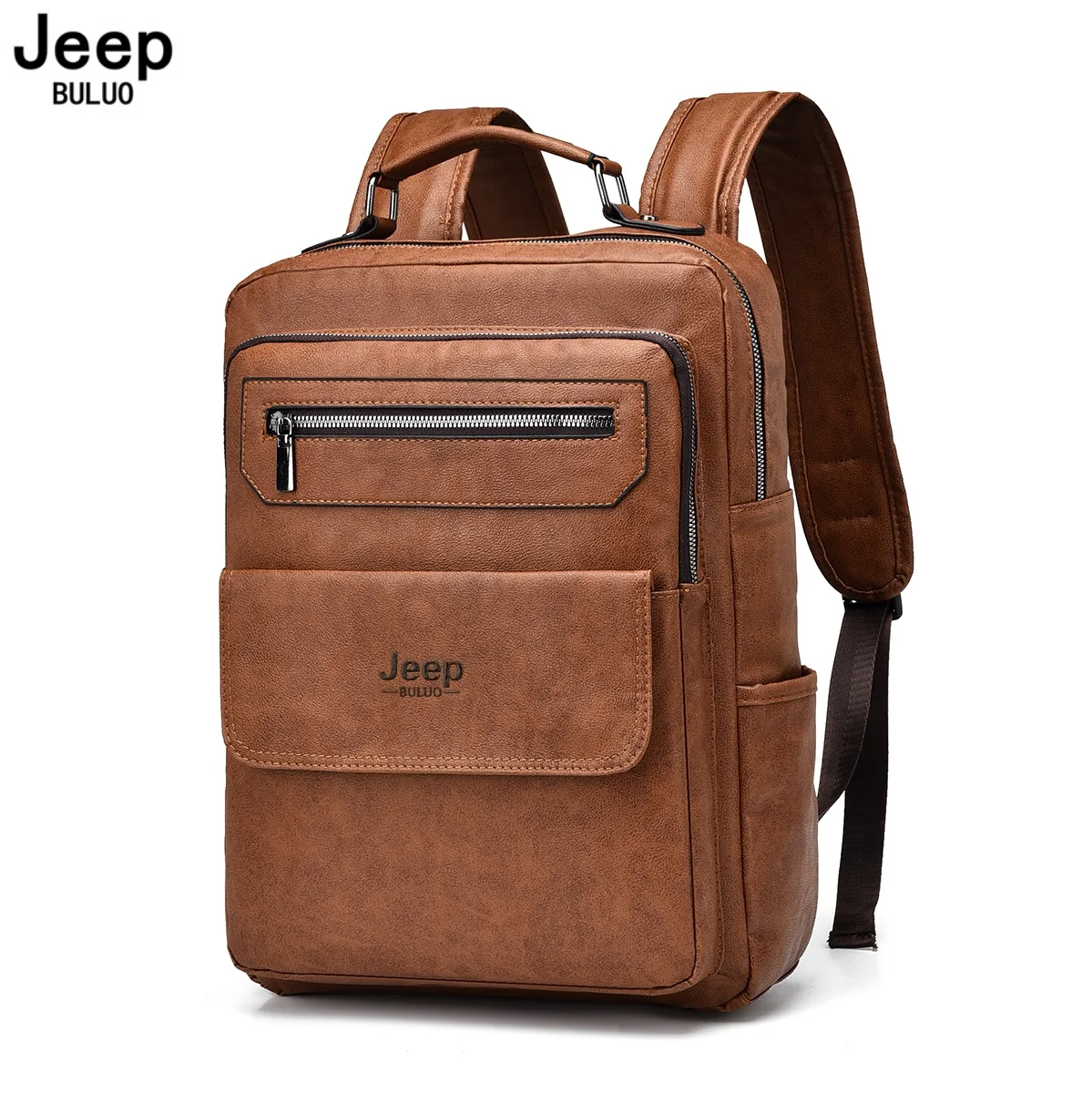
How long does a quality leather roll-top backpack typically last?
With proper care, a high-quality leather roll-top backpack can last 10-20 years or more. The roll-top mechanism has fewer failure points than zippers, and quality leather improves aesthetically with age while maintaining functionality.
Can roll-tops be opened quickly in a hurry?
Opening a roll-top requires multiple steps—unbuckling and unrolling—making them somewhat slower to access than zippered bags. This trade-off provides enhanced security and weather protection at the cost of quick access.
How do roll-tops perform for air travel and as carry-ons?
Roll-tops make excellent travel bags because their adjustable capacity can compress to meet carry-on requirements or expand to accommodate souvenirs for the return journey. The secure closure also prevents items from spilling during the screening process.
Modern Innovations in Roll-Top Design
While roll-tops have traditional origins, modern designs have evolved to address contemporary needs:
- Quick-release mechanisms – Magnetic clasps or specialized hooks that maintain security while allowing faster access than traditional buckles
- Hybrid closure systems – Combinations of roll-tops with side-access zippers that provide weather protection for the main compartment while allowing quick retrieval of frequently used items
- Tech integration – Padded laptop sleeves, cable pass-throughs, and power bank pockets designed specifically for digital devices
- Advanced ergonomics – Contoured straps, load lifters, and breathable back panels that enhance comfort for daily urban use
These innovations have helped roll-top designs evolve beyond their utilitarian origins while preserving their core functional benefits. The integration of specialized compartments for modern tech addresses one of the traditional limitations of single-compartment roll-tops.
Leather has adapted alongside these design innovations. Modern tanning techniques create leather that’s lighter and more flexible while maintaining durability—ideal for the repeated folding required by roll-tops. Water-resistant treatments have also improved, enhancing leather’s natural properties to create bags that perform better in adverse conditions.
The Environmental Perspective of Leather Roll-Tops
Quality leather roll-top backpacks offer environmental advantages worth considering. While initial production has environmental costs, the exceptional durability of these bags means they can remain in use for decades rather than years—creating a smaller environmental footprint over time compared to bags that require frequent replacement.
The repairability of leather and mechanical closures further extends this advantage. Unlike fused synthetic materials that cannot be mended once damaged, quality leather bags can be restored through professional repair or even gain character from minor wear. Buckles and straps can be replaced individually rather than requiring disposal of the entire bag.
When properly cared for, leather ages through a natural process that enhances its appearance rather than degrading it. This “aging up” rather than “wearing out” encourages longer ownership and contributes to reduced consumption overall.
At the end of an extremely long useful life, natural materials like vegetable-tanned leather biodegrade more readily than synthetic alternatives, leaving less permanent waste.
Conclusion
The roll-top leather backpack represents a remarkable marriage of traditional design principles with practical functionality. Its distinctive closure system creates a backpack that adapts to your needs while providing superior protection from the elements—all wrapped in a material that develops unique character over time.
The physics behind the roll-top mechanism explains its effectiveness: multiple overlapping layers create barriers against water intrusion, while the flexible nature of the design allows for capacity adjustment that fixed bags simply cannot match. When combined with quality leather, this design creates a backpack that is simultaneously resilient and refined.
While roll-tops require more steps to access than zippered alternatives, this trade-off provides enhanced security and weather protection that many users find well worth the extra moment or two. The simplicity of the design, with fewer mechanical components to fail, contributes to exceptional longevity.
For those who value versatility, protection, and timeless style, the roll-top leather backpack continues to prove itself as a design that elegantly solves multiple carrying challenges through one ingenious mechanism.

